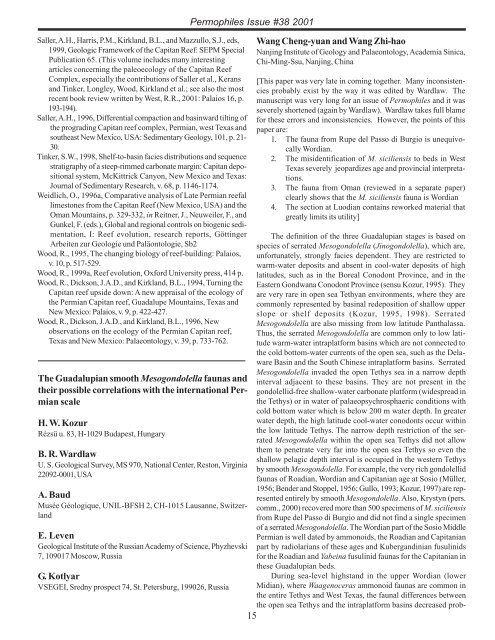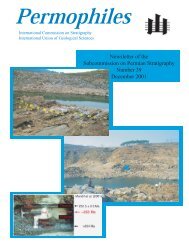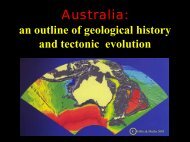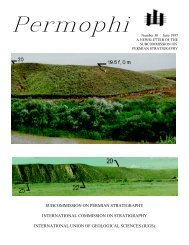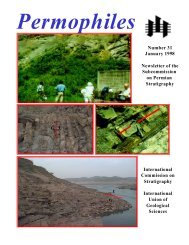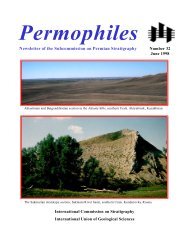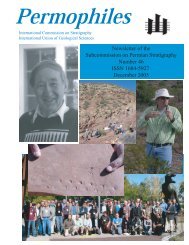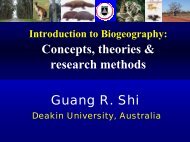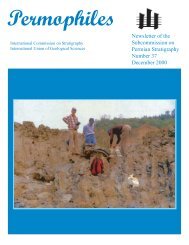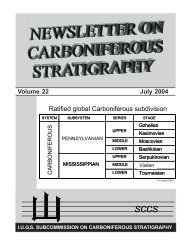Newsletter of the Subcommission on Permian Stratigraphy Number ...
Newsletter of the Subcommission on Permian Stratigraphy Number ...
Newsletter of the Subcommission on Permian Stratigraphy Number ...
You also want an ePaper? Increase the reach of your titles
YUMPU automatically turns print PDFs into web optimized ePapers that Google loves.
Saller, A.H., Harris, P.M., Kirkland, B.L., and Mazzullo, S.J., eds,1999, Geologic Framework <str<strong>on</strong>g>of</str<strong>on</strong>g> <str<strong>on</strong>g>the</str<strong>on</strong>g> Capitan Reef: SEPM SpecialPublicati<strong>on</strong> 65. (This volume includes many interestingarticles c<strong>on</strong>cerning <str<strong>on</strong>g>the</str<strong>on</strong>g> paleoecology <str<strong>on</strong>g>of</str<strong>on</strong>g> <str<strong>on</strong>g>the</str<strong>on</strong>g> Capitan ReefComplex, especially <str<strong>on</strong>g>the</str<strong>on</strong>g> c<strong>on</strong>tributi<strong>on</strong>s <str<strong>on</strong>g>of</str<strong>on</strong>g> Saller et al., Keransand Tinker, L<strong>on</strong>gley, Wood, Kirkland et al.; see also <str<strong>on</strong>g>the</str<strong>on</strong>g> mostrecent book review written by West, R.R., 2001: Palaios 16, p.193-194).Saller, A.H., 1996, Differential compacti<strong>on</strong> and basinward tilting <str<strong>on</strong>g>of</str<strong>on</strong>g><str<strong>on</strong>g>the</str<strong>on</strong>g> prograding Capitan reef complex, <strong>Permian</strong>, west Texas andsou<str<strong>on</strong>g>the</str<strong>on</strong>g>ast New Mexico, USA: Sedimentary Geology, 101, p. 21-30.Tinker, S.W., 1998, Shelf-to-basin facies distributi<strong>on</strong>s and sequencestratigraphy <str<strong>on</strong>g>of</str<strong>on</strong>g> a steep-rimmed carb<strong>on</strong>ate margin: Capitan depositi<strong>on</strong>alsystem, McKittrick Cany<strong>on</strong>, New Mexico and Texas:Journal <str<strong>on</strong>g>of</str<strong>on</strong>g> Sedimentary Research, v. 68, p. 1146-1174.Weidlich, O., 1996a, Comparative analysis <str<strong>on</strong>g>of</str<strong>on</strong>g> Late <strong>Permian</strong> reefallimest<strong>on</strong>es from <str<strong>on</strong>g>the</str<strong>on</strong>g> Capitan Reef (New Mexico, USA) and <str<strong>on</strong>g>the</str<strong>on</strong>g>Oman Mountains, p. 329-332, in Reitner, J., Neuweiler, F., andGunkel, F. (eds.), Global and regi<strong>on</strong>al c<strong>on</strong>trols <strong>on</strong> biogenic sedimentati<strong>on</strong>,I: Reef evoluti<strong>on</strong>, research reports, GöttingerArbeiten zur Geologie und Palä<strong>on</strong>tologie, Sb2Wood, R., 1995, The changing biology <str<strong>on</strong>g>of</str<strong>on</strong>g> reef-building: Palaios,v. 10, p. 517-529.Wood, R., 1999a, Reef evoluti<strong>on</strong>, Oxford University press, 414 p.Wood, R., Dicks<strong>on</strong>, J.A.D., and Kirkland, B.L., 1994, Turning <str<strong>on</strong>g>the</str<strong>on</strong>g>Capitan reef upside down: A new appraisal <str<strong>on</strong>g>of</str<strong>on</strong>g> <str<strong>on</strong>g>the</str<strong>on</strong>g> ecology <str<strong>on</strong>g>of</str<strong>on</strong>g><str<strong>on</strong>g>the</str<strong>on</strong>g> <strong>Permian</strong> Capitan reef, Guadalupe Mountains, Texas andNew Mexico: Palaios, v. 9, p. 422-427.Wood, R., Dicks<strong>on</strong>, J.A.D., and Kirkland, B.L., 1996, Newobservati<strong>on</strong>s <strong>on</strong> <str<strong>on</strong>g>the</str<strong>on</strong>g> ecology <str<strong>on</strong>g>of</str<strong>on</strong>g> <str<strong>on</strong>g>the</str<strong>on</strong>g> <strong>Permian</strong> Capitan reef,Texas and New Mexico: Palae<strong>on</strong>tology, v. 39, p. 733-762.The Guadalupian smooth Mesog<strong>on</strong>dolella faunas and<str<strong>on</strong>g>the</str<strong>on</strong>g>ir possible correlati<strong>on</strong>s with <str<strong>on</strong>g>the</str<strong>on</strong>g> internati<strong>on</strong>al <strong>Permian</strong>scaleH. W. KozurRézsü u. 83, H-1029 Budapest, HungaryB. R. WardlawU. S. Geological Survey, MS 970, Nati<strong>on</strong>al Center, Rest<strong>on</strong>, Virginia22092-0001, USAA. BaudMusée Géologique, UNIL-BFSH 2, CH-1015 Lausanne, SwitzerlandE. LevenGeological Institute <str<strong>on</strong>g>of</str<strong>on</strong>g> <str<strong>on</strong>g>the</str<strong>on</strong>g> Russian Academy <str<strong>on</strong>g>of</str<strong>on</strong>g> Science, Phyzhevski7, 109017 Moscow, RussiaG. KotlyarVSEGEI, Sredny prospect 74, St. Petersburg, 199026, RussiaPermophiles Issue #38 200115Wang Cheng-yuan and Wang Zhi-haoNanjing Institute <str<strong>on</strong>g>of</str<strong>on</strong>g> Geology and Palae<strong>on</strong>tology, Academia Sinica,Chi-Ming-Ssu, Nanjing, China[This paper was very late in coming toge<str<strong>on</strong>g>the</str<strong>on</strong>g>r. Many inc<strong>on</strong>sistenciesprobably exist by <str<strong>on</strong>g>the</str<strong>on</strong>g> way it was edited by Wardlaw. Themanuscript was very l<strong>on</strong>g for an issue <str<strong>on</strong>g>of</str<strong>on</strong>g> Permophiles and it wasseverely shortened (again by Wardlaw). Wardlaw takes full blamefor <str<strong>on</strong>g>the</str<strong>on</strong>g>se errors and inc<strong>on</strong>sistencies. However, <str<strong>on</strong>g>the</str<strong>on</strong>g> points <str<strong>on</strong>g>of</str<strong>on</strong>g> thispaper are:1. The fauna from Rupe del Passo di Burgio is unequivocallyWordian.2. The misidentificati<strong>on</strong> <str<strong>on</strong>g>of</str<strong>on</strong>g> M. siciliensis to beds in WestTexas severely jeopardizes age and provincial interpretati<strong>on</strong>s.3. The fauna from Oman (reviewed in a separate paper)clearly shows that <str<strong>on</strong>g>the</str<strong>on</strong>g> M. siciliensis fauna is Wordian4. The secti<strong>on</strong> at Luodian c<strong>on</strong>tains reworked material thatgreatly limits its utility]The definiti<strong>on</strong> <str<strong>on</strong>g>of</str<strong>on</strong>g> <str<strong>on</strong>g>the</str<strong>on</strong>g> three Guadalupian stages is based <strong>on</strong>species <str<strong>on</strong>g>of</str<strong>on</strong>g> serrated Mesog<strong>on</strong>dolella (Jinog<strong>on</strong>dolella), which are,unfortunately, str<strong>on</strong>gly facies dependent. They are restricted towarm-water deposits and absent in cool-water deposits <str<strong>on</strong>g>of</str<strong>on</strong>g> highlatitudes, such as in <str<strong>on</strong>g>the</str<strong>on</strong>g> Boreal C<strong>on</strong>od<strong>on</strong>t Province, and in <str<strong>on</strong>g>the</str<strong>on</strong>g>Eastern G<strong>on</strong>dwana C<strong>on</strong>od<strong>on</strong>t Province (sensu Kozur, 1995). Theyare very rare in open sea Tethyan envir<strong>on</strong>ments, where <str<strong>on</strong>g>the</str<strong>on</strong>g>y arecomm<strong>on</strong>ly represented by basinal redepositi<strong>on</strong> <str<strong>on</strong>g>of</str<strong>on</strong>g> shallow upperslope or shelf deposits (Kozur, 1995, 1998). SerratedMesog<strong>on</strong>dolella are also missing from low latitude Panthalassa.Thus, <str<strong>on</strong>g>the</str<strong>on</strong>g> serrated Mesog<strong>on</strong>dolella are comm<strong>on</strong> <strong>on</strong>ly to low latitudewarm-water intraplatform basins which are not c<strong>on</strong>nected to<str<strong>on</strong>g>the</str<strong>on</strong>g> cold bottom-water currents <str<strong>on</strong>g>of</str<strong>on</strong>g> <str<strong>on</strong>g>the</str<strong>on</strong>g> open sea, such as <str<strong>on</strong>g>the</str<strong>on</strong>g> DelawareBasin and <str<strong>on</strong>g>the</str<strong>on</strong>g> South Chinese intraplatform basins. SerratedMesog<strong>on</strong>dolella invaded <str<strong>on</strong>g>the</str<strong>on</strong>g> open Tethys sea in a narrow depthinterval adjacent to <str<strong>on</strong>g>the</str<strong>on</strong>g>se basins. They are not present in <str<strong>on</strong>g>the</str<strong>on</strong>g>g<strong>on</strong>dolellid-free shallow-water carb<strong>on</strong>ate platform (widespread in<str<strong>on</strong>g>the</str<strong>on</strong>g> Tethys) or in water <str<strong>on</strong>g>of</str<strong>on</strong>g> palaeopsychrosphaeric c<strong>on</strong>diti<strong>on</strong>s withcold bottom water which is below 200 m water depth. In greaterwater depth, <str<strong>on</strong>g>the</str<strong>on</strong>g> high latitude cool-water c<strong>on</strong>od<strong>on</strong>ts occur within<str<strong>on</strong>g>the</str<strong>on</strong>g> low latitude Tethys. The narrow depth restricti<strong>on</strong> <str<strong>on</strong>g>of</str<strong>on</strong>g> <str<strong>on</strong>g>the</str<strong>on</strong>g> serratedMesog<strong>on</strong>dolella within <str<strong>on</strong>g>the</str<strong>on</strong>g> open sea Tethys did not allow<str<strong>on</strong>g>the</str<strong>on</strong>g>m to penetrate very far into <str<strong>on</strong>g>the</str<strong>on</strong>g> open sea Tethys so even <str<strong>on</strong>g>the</str<strong>on</strong>g>shallow pelagic depth interval is occupied in <str<strong>on</strong>g>the</str<strong>on</strong>g> western Tethysby smooth Mesog<strong>on</strong>dolella. For example, <str<strong>on</strong>g>the</str<strong>on</strong>g> very rich g<strong>on</strong>dolellidfaunas <str<strong>on</strong>g>of</str<strong>on</strong>g> Roadian, Wordian and Capitanian age at Sosio (Müller,1956; Bender and Stoppel, 1956; Gullo, 1993; Kozur, 1997) are representedentirely by smooth Mesog<strong>on</strong>dolella. Also, Krystyn (pers.comm., 2000) recovered more than 500 specimens <str<strong>on</strong>g>of</str<strong>on</strong>g> M. siciliensisfrom Rupe del Passo di Burgio and did not find a single specimen<str<strong>on</strong>g>of</str<strong>on</strong>g> a serrated Mesog<strong>on</strong>dolella. The Wordian part <str<strong>on</strong>g>of</str<strong>on</strong>g> <str<strong>on</strong>g>the</str<strong>on</strong>g> Sosio Middle<strong>Permian</strong> is well dated by amm<strong>on</strong>oids, <str<strong>on</strong>g>the</str<strong>on</strong>g> Roadian and Capitanianpart by radiolarians <str<strong>on</strong>g>of</str<strong>on</strong>g> <str<strong>on</strong>g>the</str<strong>on</strong>g>se ages and Kubergandinian fusulinidsfor <str<strong>on</strong>g>the</str<strong>on</strong>g> Roadian and Yabeina fusulinid faunas for <str<strong>on</strong>g>the</str<strong>on</strong>g> Capitanian in<str<strong>on</strong>g>the</str<strong>on</strong>g>se Guadalupian beds.During sea-level highstand in <str<strong>on</strong>g>the</str<strong>on</strong>g> upper Wordian (lowerMidian), where Waagenoceras amm<strong>on</strong>oid faunas are comm<strong>on</strong> in<str<strong>on</strong>g>the</str<strong>on</strong>g> entire Tethys and West Texas, <str<strong>on</strong>g>the</str<strong>on</strong>g> faunal differences between<str<strong>on</strong>g>the</str<strong>on</strong>g> open sea Tethys and <str<strong>on</strong>g>the</str<strong>on</strong>g> intraplatform basins decreased prob-


